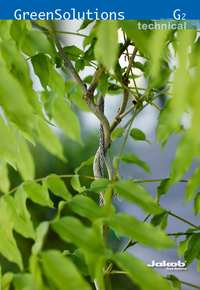
Greening with success
First planning steps for greening
Winter is the right time to think about the installation of greening. Careful planning helps to avoid errors and minimize costs. We have put together the most important aspects.
What is the purpose of the greening?

At the very beginning there should be the question of what the aim of the greening is. The manifold positive effects of greened buildings have been well investigated and proven. They can be divided into three areas:
-
improvement of the building: greenings provide shade and cooling by evaporation, thereby lowering the temperature inside buildings and save energy needed for cooling. They also protect the facade from dirt, impacts and UV rays.
-
improvement of the surrounding: more pleasant green in urban areas cancels noise, reduce the urban heat island effect, and filters microparticles and CO2.
- architectural effect: as an element of design, to create and order public spaces, to hide parts of the building or to protect from public sight.
The various objectives are not mutually exclusive, but focusing helps to make the right choice of plant and training structure for the desired long-term effect.
What should be greened? Check local conditions

The location has a decisive influence on the design possibilities of a green area. For facades, the surface should be examined for damages. It is also essential to consider the load-bearing capacity, as the weight of the plants and the supporting structure can be up to 1 kg/m2.
For a ground-based greening, sufficient soil of good quality must be available, which also provides sufficient space for the roots at depth. Under certain circumstances this can be achieved by using a trough as a planting ground.
Finally, weather and climate conditions at the desired location are important for the choice of plants: in addition to sun exposure, possible wind and snow loads must be taken into account.
Check local laws and regulations
Before installing climbing aids, the standards and regulations under building law should be checked. Under certain circumstances, permits may be necessary, or aspects of heritage and monument protection must be taken into account. Finally, attention must be paid to safety aspects such as fire protection: the plants must not prevent access to emergency entrances such as windows.
Make a long-term maintenance plan at the beginning
In principle, a vertical greening can exist as long as its supporting structure. In order to achieve the objectives of greening and to ensure the longest possible life of plants and trellis structure, long-term maintenance should be considered from the very beginning. After the plants have developed successfully, the structure should be maintained approximately every six months to annually, depending on the plant type. At this occasion, plants can be cut and fertilized and the climbing structure and facade can be examined for stability and damage.
Good planning is a prerequisite for enjoying all the benefits of greening in the long term and minimising maintenance costs. Jakob Rope Systems will be happy to advise you on how to proceed and on working with competent gardeners.
Need help? Contact us

Since good planning is vital for the sucess of a greening, do not hesitate to contact us during the early stages of your project. We are happy to advise you.
Downloads

The program is presented in two parts. The catalog GreenSolutions Technical contains all wire rope products with their technical information for your greening project.
Download
The program is presented in two parts. In the GreenSolutions reference brochure, you will find many real-world applications that show you the potential of greening.
Download